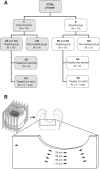In vivo dentin microhardness beneath a calcium-phosphate cement
- PMID: 20511564
- PMCID: PMC3318059
- DOI: 10.1177/0022034510369292
In vivo dentin microhardness beneath a calcium-phosphate cement
Abstract
A minimally invasive caries-removal technique preserves potentially repairable, caries-affected dentin. Mineral-releasing cements may promote remineralization of soft residual dentin. This study evaluated the in vivo remineralization capacity of resin-based calcium-phosphate cement (Ca-PO(4)) used for indirect pulp-capping. Permanent carious and sound teeth indicated for extraction were excavated and restored either with or without the Ca-PO(4) base (control), followed by adhesive restoration. Study teeth were extracted after 3 months, followed by sectioning and in vitro microhardness analysis of the cavity floor to 115-microm depth. Caries-affected dentin that received acid conditioning prior to Ca-PO(4) basing showed significantly increased Knoop hardness near the cavity floor. The non-etched group presented results similar to those of the non-treated group. Acid etching prior to cement application increased microhardness of residual dentin near the interface after 3 months in situ.
Figures



Similar articles
-
In vivo dentin remineralization by calcium-phosphate cement.J Dent Res. 2010 Mar;89(3):286-91. doi: 10.1177/0022034509360155. Epub 2010 Feb 5. J Dent Res. 2010. PMID: 20139340 Clinical Trial.
-
Dentin microhardness of primary teeth undergoing partial carious removal.J Clin Pediatr Dent. 2012 Summer;36(4):363-7. J Clin Pediatr Dent. 2012. PMID: 23019833 Clinical Trial.
-
Analysis of primary tooth dentin after indirect pulp capping.J Dent Child (Chic). 2008 Sep-Dec;75(3):295-300. J Dent Child (Chic). 2008. PMID: 19040817
-
Dentin rehardening after indirect pulp treatment in primary teeth.J Dent Child (Chic). 2009 Sep-Dec;76(3):223-8. J Dent Child (Chic). 2009. PMID: 19941765 Clinical Trial.
-
Dental remineralization via poly(amido amine) and restorative materials containing calcium phosphate nanoparticles.Int J Oral Sci. 2019 May 9;11(2):15. doi: 10.1038/s41368-019-0048-z. Int J Oral Sci. 2019. PMID: 31068570 Free PMC article. Review.
Cited by
-
Accounting for measurement reliability to improve the quality of inference in dental microhardness research: a worked example.Clin Oral Investig. 2016 Jul;20(6):1143-9. doi: 10.1007/s00784-015-1600-7. Epub 2015 Sep 19. Clin Oral Investig. 2016. PMID: 26385688
-
Chemo-mechanical characterization of carious dentine using Raman microscopy and Knoop microhardness.R Soc Open Sci. 2020 May 20;7(5):200404. doi: 10.1098/rsos.200404. eCollection 2020 May. R Soc Open Sci. 2020. PMID: 32537229 Free PMC article.
-
Comparative evaluation of bioactive cements on biomimetic remineralization of dentin.J Clin Exp Dent. 2020 Mar 1;12(3):e291-e299. doi: 10.4317/jced.56500. eCollection 2020 Mar. J Clin Exp Dent. 2020. PMID: 32190201 Free PMC article.
-
Efficacy of cavity liners with/without atmospheric cold helium plasma jet for dentin remineralization.Biomater Investig Dent. 2020 Aug 17;7(1):120-125. doi: 10.1080/26415275.2020.1803074. Biomater Investig Dent. 2020. PMID: 32939456 Free PMC article.
-
Therapeutic effects of novel resin bonding systems containing bioactive glasses on mineral-depleted areas within the bonded-dentine interface.J Mater Sci Mater Med. 2012 Jun;23(6):1521-32. doi: 10.1007/s10856-012-4606-6. Epub 2012 Apr 1. J Mater Sci Mater Med. 2012. PMID: 22466816
References
-
- Angker L, Nijhof N, Swain MV, Kilpatrick NM. (2004). Influence of hydration and mechanical characterization of carious primary dentine using an ultra-micro indentation system (UMIS). Eur J Oral Sci 112:231-236 - PubMed
-
- Banerjee A, Sherriff M, Kidd EA, Watson TF. (1999). A confocal microscopic study relating the autofluorescence of carious dentine to its microhardness. Br Dent J 187:206-210 - PubMed
-
- Bjørndal L, Larsen T, Thylstrup A. (1997). A clinical and microbiological study of deep carious lesions during stepwise excavation using long treatment intervals. Caries Res 31:411-417 - PubMed
-
- Boston DW. (2003). New device for selective dentin caries removal. Quintessence Int 34:678-685 - PubMed
-
- Chow LC, Hirayama S, Takagi S, Parry E. (2000). Diametral tensile strength and compressive strength of a calcium phosphate cement: effect of applied pressure. J Biomed Mater Res 53:511-517 - PubMed
Publication types
MeSH terms
Substances
Grants and funding
LinkOut - more resources
Full Text Sources

